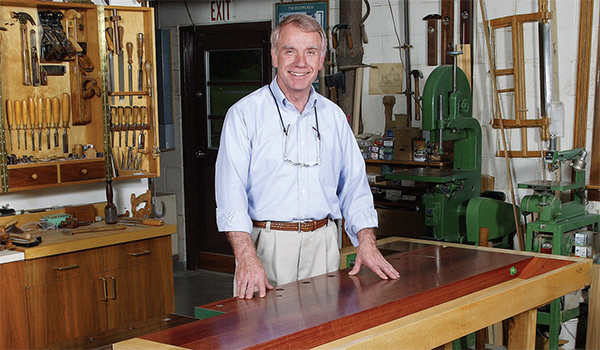
Frank Klausz is known throughout the woodworking world for his expertise, particularly with dovetail joints. But to the people who can afford to buy one of his $6,000 lowboys, he’s just Frank’s Cabinet Shop in Pluckemin, New Jersey. Fortunately his reproductions of Queen Anne, Chippendale and Duncan Phyfe, to name just a few, have found an enthusiastic clientele among his affluent New Jersey neighbors.
Frank left Communist Hungary in the late 1960s, more for economical opportunities than political reasons, and he and his wife eventually settled in New Jersey in 1968. Having achieved journeyman cabinetmaker status back in Hungary, he was eager to start his own business and was interested in learning more about his craft. To familiarize himself with the American version of the craft, he attended several seminars & but he wasn’t happy with what he found.
“The craft was very messed up in America,” Frank recalled, “so I worked in an interior decorator shop and did antique restoration, upholstery, and drapery hangings. As a cabinetmaker, I didn’t know much about upholstery, but I did learn quickly.”
The management of the shop didn’t suit him and, unable to find another job, Frank decided to do what he loved to do — open his own cabinetmaking business in 1972. It was slow at first. Customers who could afford handmade furniture only knew him as the guy who restored their furniture. It took time, but Frank was able to turn most of them into customers for his reproduction furniture.
Frank’s subsequent move into the higher realms of woodworking was somewhat precipitated by the appearance of “Fine Woodworking” magazine in the mid-1970s. Many people were inspired by those early articles to take up woodworking as a serious hobby or even career. Frank had a different reaction. As an already established woodworker, he disagreed with many of the articles.
“So I called them and started yelling at them,” Frank recalled, “and they asked me just who the hell I was, and what was my problem. So, they came to visit me in my shop and wrote about me and asked me to write.”
The magazine often featured point-counterpoint discussions by Frank and Ian Kirby.
“If Ian Kirby said black, then Frank Klausz said white and on and on,” Frank noted, “They used our names to sell magazines. Today Ian Kirby and I are good friends. Although we do things differently, we have great respect for each other as craftsmen.”
Along with the articles, Frank created videos, and people started asking him to conduct seminars and lectures. And so his name spread far and wide!
Thirty years after his first mostly negative assessment of woodworking in America, what does Frank think of the craft today?
“Still messed up and maybe a little more,” Frank declared, and then explained. “For anyone just wanting to make a piece of furniture for themselves, it’s a very simple craft that should be accessible to anybody. You can learn from books and videos, but you need to find just the right person and learn from other people’s mistakes.”
Known for his dovetails, Frank looked at thousands of pieces of furniture and conducted his own 10-year research program. He found that 90 percent of the world did it the way he was taught in Hungary by his father.
“When I do one of my seminars, I can teach anyone to dovetail my way in 10 minutes. But it’s nothing new, and I also talk about how the Egyptians were doing open dovetailing 3,000 years ago.”
Aside from his seminars, videos and articles, Frank still runs a professional cabinetmaking shop. With many wealthy clients nearby work can range from a mahogany bar with fluted columns to kitchen cabinets with one-piece cherrywood panel doors to Jacobean conference tables for the New Jersey State House. His clients have included Johnson & Johnson, Jacqueline Kennedy Onassis, and Malcolm Forbes. The latter work for the Forbes house was featured in “Architectural Digest.”
With his busy schedule, he doesn’t try to do it all himself. Two to three teams of employees may be working on different projects. And each team captain may have one to three guys helping him.
“Sometimes I take jobs that are complicated,” Frank explained, “or maybe a small job when it would take more time to explain than to just make it myself. I just made a couple of mahogany straight-legged Chippendale tables for an old metal tray. They turned out beautiful, but now I have to restore the tray, and all the painting and picture varnishing is hard to explain to someone. So I’ll just do it myself.”
Though he admits he often has too many irons in the fire, Frank still enjoys sharing his knowledge. Even though it takes time away from his paid projects, he takes frequent phone calls from woodworkers who’ve read about him and need some advice.
“What gives me strength to keep going is that so many people want to do for a hobby what I do for a living. I cut wood, and I am well paid for it. Most people like to cut wood just for the hell of it. I will keep doing this as long as I have a smile on my face and can still be nice to people.”
Frank has just redone his web site, where you can see examples of his work, his seminars, and a little of his philosophy.







